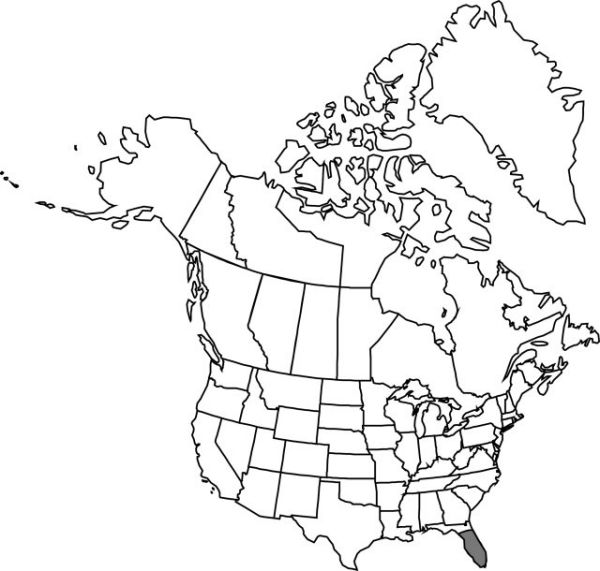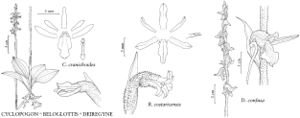Difference between revisions of "Cyclopogon cranichoides"
Beih. Bot. Centralbl. 37: 387. 1920.
FNA>Volume Importer |
imported>Volume Importer |
||
| (6 intermediate revisions by 2 users not shown) | |||
| Line 7: | Line 7: | ||
|year=1920 | |year=1920 | ||
}} | }} | ||
| − | |basionyms={{Treatment/ID/ | + | |special_status={{Treatment/ID/Special_status |
| + | |code=F | ||
| + | |label=Illustrated | ||
| + | }} | ||
| + | |basionyms={{Treatment/ID/Basionym | ||
|name=Pelexia cranichoides | |name=Pelexia cranichoides | ||
|authority=Grisebach | |authority=Grisebach | ||
| + | |rank=species | ||
| + | |publication_title=Cat. Pl. Cub., | ||
| + | |publication_place=269. 1866 | ||
}} | }} | ||
|synonyms={{Treatment/ID/Synonym | |synonyms={{Treatment/ID/Synonym | ||
|name=Beadlea cranichoides | |name=Beadlea cranichoides | ||
|authority=(Grisebach) Small | |authority=(Grisebach) Small | ||
| − | }}{{Treatment/ID/Synonym | + | |rank=species |
| + | }} {{Treatment/ID/Synonym | ||
|name=Beadlea storeri | |name=Beadlea storeri | ||
|authority=(Chapman) Small | |authority=(Chapman) Small | ||
| − | }}{{Treatment/ID/Synonym | + | |rank=species |
| + | }} {{Treatment/ID/Synonym | ||
|name=Sauroglossum cranichoides | |name=Sauroglossum cranichoides | ||
|authority=(Grisebach) Ames | |authority=(Grisebach) Ames | ||
| − | }}{{Treatment/ID/Synonym | + | |rank=species |
| + | }} {{Treatment/ID/Synonym | ||
|name=Spiranthes cranichoides | |name=Spiranthes cranichoides | ||
|authority=(Grisebach) Cogniaux | |authority=(Grisebach) Cogniaux | ||
| − | }}{{Treatment/ID/Synonym | + | |rank=species |
| + | }} {{Treatment/ID/Synonym | ||
|name=Spiranthes storeri | |name=Spiranthes storeri | ||
|authority=Chapman | |authority=Chapman | ||
| + | |rank=species | ||
}} | }} | ||
|hierarchy=Orchidaceae;Orchidaceae subfam. Orchidoideae;Orchidaceae tribe Cranichideae;Orchidaceae (tribe Cranichideae) subtribe Spiranthinae;Cyclopogon;Cyclopogon cranichoides | |hierarchy=Orchidaceae;Orchidaceae subfam. Orchidoideae;Orchidaceae tribe Cranichideae;Orchidaceae (tribe Cranichideae) subtribe Spiranthinae;Cyclopogon;Cyclopogon cranichoides | ||
| Line 41: | Line 53: | ||
|elevation=0–100 m | |elevation=0–100 m | ||
|distribution=Fla.;West Indies;Central America;n South America. | |distribution=Fla.;West Indies;Central America;n South America. | ||
| − | |discussion=<p>Fruit production in Cyclopogon cranichoides is pollen limited (R. N. Calvo 1990). Natural fruit set was 26–62% over a 4-year period, whereas hand pollinations gave better than 96% fruit set. Contrary to most other studies of orchids, Calvo did not detect a cost of reproduction associated with resource constraints.</p> | + | |discussion=<p>Fruit production in <i>Cyclopogon cranichoides</i> is pollen limited (R. N. Calvo 1990). Natural fruit set was 26–62% over a 4-year period, whereas hand pollinations gave better than 96% fruit set. Contrary to most other studies of orchids, Calvo did not detect a cost of reproduction associated with resource constraints.</p> |
|tables= | |tables= | ||
|references={{Treatment/Reference | |references={{Treatment/Reference | ||
| Line 53: | Line 65: | ||
-->{{#Taxon: | -->{{#Taxon: | ||
name=Cyclopogon cranichoides | name=Cyclopogon cranichoides | ||
| − | |||
|authority=(Grisebach) Schlechter | |authority=(Grisebach) Schlechter | ||
|rank=species | |rank=species | ||
| Line 67: | Line 78: | ||
|publication title=Beih. Bot. Centralbl. | |publication title=Beih. Bot. Centralbl. | ||
|publication year=1920 | |publication year=1920 | ||
| − | |special status= | + | |special status=Illustrated |
| − | |source xml=https:// | + | |source xml=https://bitbucket.org/aafc-mbb/fna-data-curation/src/2e0870ddd59836b60bcf96646a41e87ea5a5943a/coarse_grained_fna_xml/V26/V26_1061.xml |
|subfamily=Orchidaceae subfam. Orchidoideae | |subfamily=Orchidaceae subfam. Orchidoideae | ||
|tribe=Orchidaceae tribe Cranichideae | |tribe=Orchidaceae tribe Cranichideae | ||
Latest revision as of 21:11, 5 November 2020
Herbs small, to 40 cm. Roots fusiform, to 4.5 cm × 4–8 mm, fleshy. Stems subterranean, short. Leaves 3–8; petiole spreading to suberect, 1.1–3.5(–5.5) cm; blade abaxially purplish, adaxially dark purplish green, sometimes with whitish markings, broadly elliptic to ovate, 2.5–8 × 1.3–3.8 cm, apex obtuse to acute. Inflorescences mottled, purplish; scape pubescent; raceme continuously elongating as fruits mature, to 15 cm, pubescent; floral bracts mottled, lanceolate, longer than ovary. Flowers tubular-funnelform; sepals greenish brown, pubescent; dorsal sepal midvein and margins dark near apex, narrowly elliptic to narrowly pandurate, 3.5–5 × 1.2–2 mm, apex acute; lateral sepals often reflexed, narrowly elliptic to narrowly pandurate, 4–6 × 1–1.5 mm, apex acute; petals greenish-brownish proximally, greenish white distally with midvein and apical margins dark brown, narrowly spatulate-oblanceolate, 4.5 × 0.5–1 mm, apex acute, oblique; lip white, canaliculate, oblong, constricted distal to middle, broadest proximal to constriction, to 5 × 2.5 mm, base gibbose, with pair of tubercles, margins entire, apex slightly flared; column slender, 3.5 mm; pollinia yellow; pedicellate ovary 4–7 mm. Capsules erect, ellipsoid, 6–8 × 3.5–4.5 mm.
Phenology: Flowering Feb–Mar.
Habitat: In humus of shady moist hammocks
Elevation: 0–100 m
Distribution

Fla., West Indies, Central America, n South America.
Discussion
Fruit production in Cyclopogon cranichoides is pollen limited (R. N. Calvo 1990). Natural fruit set was 26–62% over a 4-year period, whereas hand pollinations gave better than 96% fruit set. Contrary to most other studies of orchids, Calvo did not detect a cost of reproduction associated with resource constraints.
